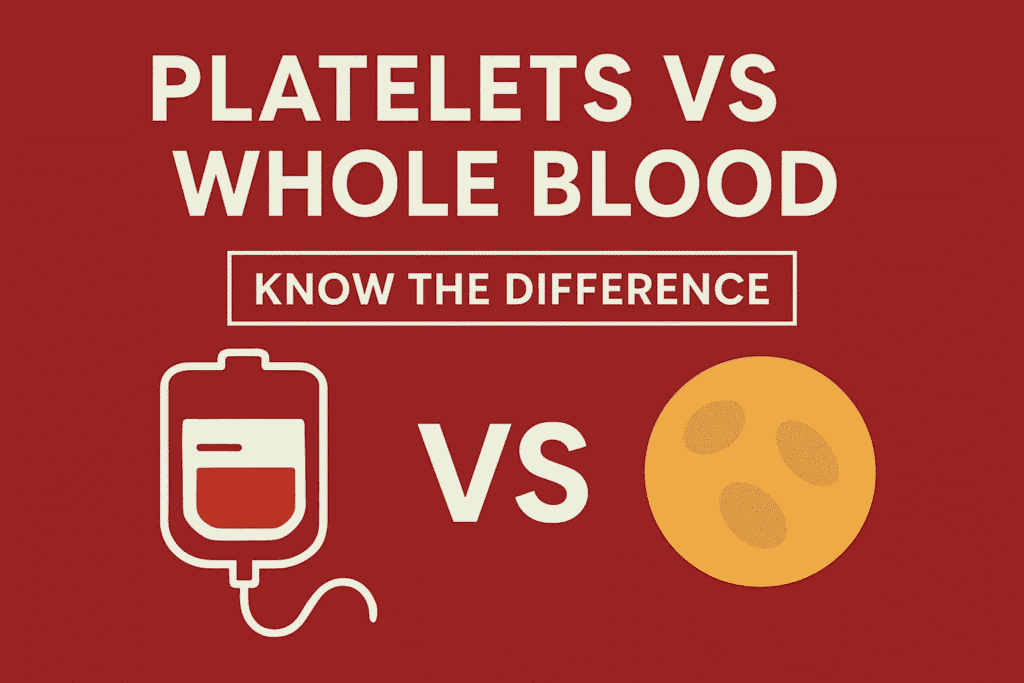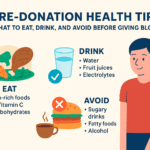When we think of blood donation, most of us imagine donating a single bag of blood that helps someone in need. But did you know that there are different types of blood donations — and one of the most powerful among them is platelet donation?
While both whole blood and platelet donations save lives, they work in slightly different ways and help patients with different medical needs. Let’s understand how they differ and why both are equally important.
What Is Whole Blood Donation?
Whole blood donation is the most common and simplest type of donation. It involves giving about 350–450 ml of blood that contains red blood cells, white blood cells, plasma, and platelets.
After donation, your blood is usually separated into these components so that doctors can use what’s most needed for each patient — for example, red blood cells for anemia patients or plasma for burn victims.
Whole blood donation typically takes about 10–15 minutes, and donors can give blood every 3 months (for men) and every 4 months (for women).
What Is Platelet Donation?
Platelets are tiny cell fragments in our blood that help it clot and stop bleeding. They play a crucial role in healing wounds and preventing excessive blood loss.
Platelet donation is done through a process called apheresis. During this process:
-
Blood is drawn from your arm into a special machine.
-
The machine separates platelets and returns the remaining blood components (like red cells and plasma) back to your body.
This process usually takes 60–90 minutes, and it’s completely safe. Since your body replaces platelets faster than red blood cells, you can donate platelets every 2 weeks, up to 24 times a year.
Who Needs Platelet Donations?
Platelets are vital for patients whose bodies can’t produce enough on their own. This includes:
-
Cancer patients undergoing chemotherapy
-
Bone marrow transplant patients
-
Accident victims with severe bleeding
-
Patients with blood disorders like leukemia or aplastic anemia
-
Surgery or organ transplant patients
Since platelets have a short shelf life of just 5 days, hospitals constantly need new donors to maintain supply.
Platelets vs. Whole Blood Donation: Key Differences
| Aspect | Whole Blood Donation | Platelet Donation |
|---|---|---|
| What’s Donated | Red cells, white cells, platelets, and plasma | Only platelets |
| Time Required | 10–15 minutes | 60–90 minutes |
| Donation Frequency | Every 3–4 months | Every 2 weeks |
| Shelf Life | Red cells: up to 42 days | Platelets: only 5 days |
| Beneficiaries | Accident victims, anemic patients | Cancer, surgery, and transplant patients |
Both types of donation are essential — whole blood provides the foundation for emergency needs, while platelet donation saves patients fighting long-term critical illnesses.
Why Platelet Donation Matters More Than Ever
With the rise in cancer treatments, surgeries, and transplants in India, the demand for platelets has increased sharply. Many hospitals face shortages because fewer people donate platelets — mostly due to lack of awareness.
One platelet donation can help up to three patients, making it one of the most impactful forms of donation. Moreover, since your body replenishes platelets quickly, it’s an easy way to help more often.
Every donor who contributes platelets becomes a lifeline for patients who depend on these tiny blood cells for recovery and survival.
Be the Reason Someone Smiles Today
Whether you choose to donate whole blood or platelets, every donation counts. Both play a unique and life-saving role. The difference is in the frequency and purpose, not the impact.
If you’re healthy, above 18 years of age, and meet the basic medical criteria, consider registering as a platelet donor at your nearest blood bank or hospital.
Your small act of kindness could mean the world to someone in need.
Final Thoughts
Blood donation saves lives — and platelet donation goes a step further by supporting patients fighting critical conditions like cancer. While the process takes a bit longer, the impact is immense.


